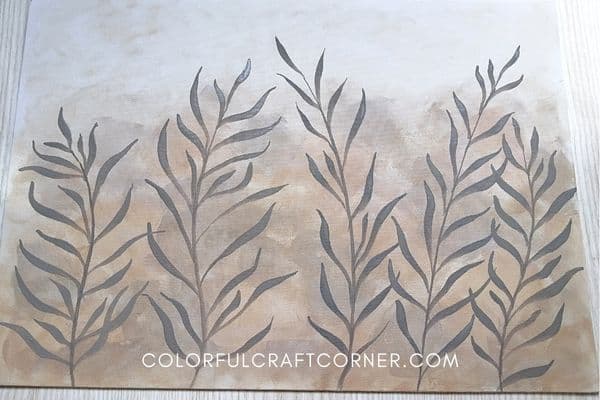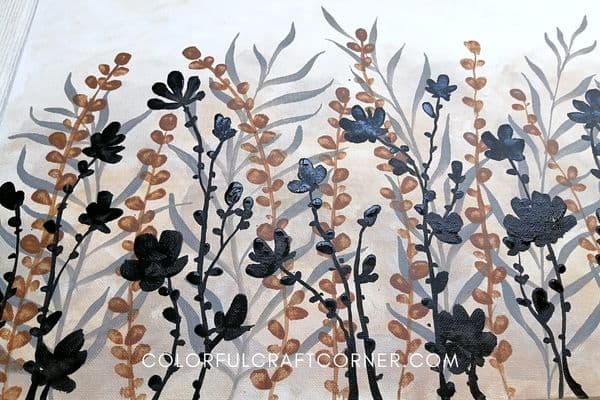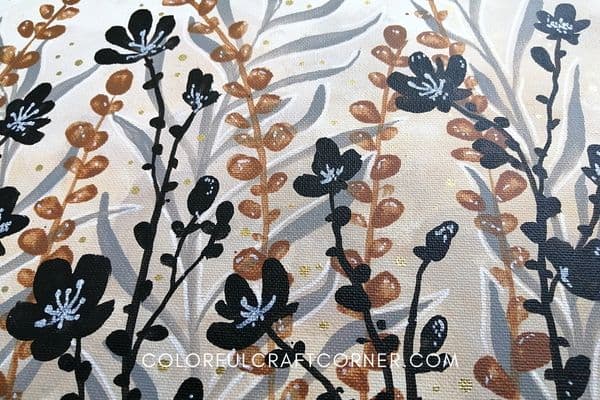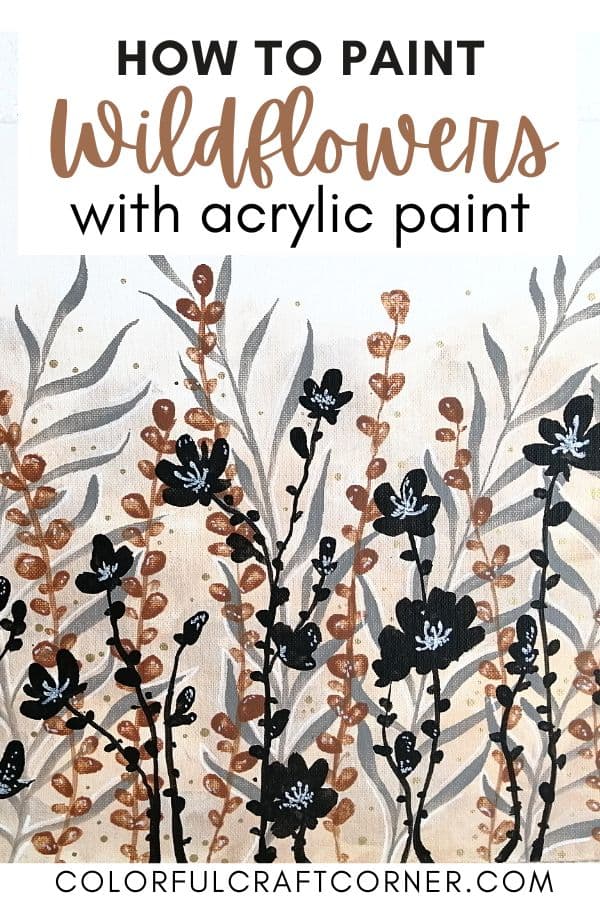Simple wildflower canvas painting for beginners
In this blog post, I’ll show you how to paint simple wildflowers with acrylic paint. It’s an easy abstract flower painting for beginners using only a couple of colors and a few brushes.
I love to walk in nature, and I’m lucky we have tons of woods and meadows with fantastic colorful flowers around our city. The inspiration for this painting was a field of wildflowers at sunset at the end of Summer. They have warm tones, some of them are almost dry. The weather is still warm, but the light breeze makes you sit there and watch the sunset.
Maybe you’ve never watched the sunset on a field of wildflowers, but I love it! It’s relaxing, just like painting which has become popular in recent years.
So, I wanted to create a painting that has the same vibe and fits our bedroom colors.
Now, let’s dive into the painting!
DISCLOSURE: THIS POST MAY CONTAIN AFFILIATE LINKS, MEANING I GET A COMMISSION IF YOU DECIDE TO MAKE A PURCHASE THROUGH MY LINKS, AT NO COST TO YOU. PLEASE READ MY DISCLOSURE FOR MORE INFO.
Tools and supplies:
- a canvas panel (you can use a canvas board),
- acrylic paints (see the exact colors in the list below),
- a medium round brush,
- a cat’s tongue brush,
- a large flat brush,
- a sponge,
- a tray or paint palette,
- white permanent marker,
- metallic marker.
Colors used in this painting:
- titanium white,
- yellow ochre,
- burnt sienna,
- raw umber,
- lamp black.
Except for the white, I haven’t used any of these colors in their pure form. I like to mix and create my own colors.
PRO TIP: Always mix enough paint for each layer. You don’t want to run out of shade in the middle of the painting because it’s hard to mix the same color again.
Step-by-step tutorial
Acrylic paint dries pretty fast, especially if you mix it with water and apply it in a thin layer. Even though I created this painting in layers, I didn’t have to let it dry between applying new elements.
The time I used to mix the colors was enough for the previous coat to dry.
Painting a blurry background

The first thing you need to paint is a blurry background. You can easily achieve that with a sponge.
I mixed two beige or neutral colors: sand and nude. I added nude patches with the sponge randomly on the lower 3/4 part of the canvas, Then, I filled in the gaps with the sand color.
To merge the colors and achieve a blurry effect, I thinned up some white paint and applied it in a circular motion.
My recommendation: do not clear your palette. Let your white mix with the other pigments. Also, spread some of the off-white pigments on the empty space left on the top part of your canvas.
TIP: You can also paint the background using a palette knife. It will also add a cool texture, but you will need more paint.
Layers
I thought that the easiest way to paint a meadow of wildflowers was by layering grass and flowers. So, I picked one element for each layer and chose the colors from lightest to darkest to achieve depth.
Make sure they overlap to create depth, don’t just paint the elements in ‘gaps’ and empty spaces.
First layer

For the first layer, I picked greenery with long and pointy leaves.
To achieve the taupe color, I mixed: white, raw umber, and a hint of black. Thin up the paint with water so it will easily spread.
PRO TIP: Test the stems and leaves on paper before applying them to the canvas.
I’ve watched some watercolor painting courses the past couple of months and loved how they painted leaves. My favorite is the simple leaves you can make in one brush stroke. First, load the brush with paint. Start lightly touching the paper, press it down for the body, and release as you approach the stem to make the ending fine.
Don’t make the leaves symmetric, make some overlaps and curves, some longer or shorter, to achieve a natural look.
NOTE* I should have made this color lighter to achieve a better dimensional look.
Second coat

For the second layer, I picked foliage with round leaves. I wanted to make it in a warmer tone, so I mixed a nice caramel shade. After finishing the painting, I realized I should have made it less saturated to harmonize with the other colors.
To create the caramel color, I blended: burnt sienna, yellow ochre, white, and a bit of raw umber.
I used the round brush to draw the stems, for the leaves, I used a cat tongue brush. The ‘secret’ of painting these leaves is rotating and pressing the brush harder or lighter to alter the size and shape.
Make sure your brush is always loaded with paint because you won’t be able to create the leaves with a dry brush, or you will need to go over them again.
Third color

It was time for actual flowers, right? I made them the star of the acrylic painting by putting them in front and making them the darkest.
Making them black would have been too harsh, so I opted for dark brown. I mixed all the colors I had on my tray and added black and raw umber until I was satisfied with the shade.
I painted the stems with the round brush, then switched to the large flat brush to paint the blooms and buds. It’s best to change the size and orientation of the petals to create a natural look.
Small details

I like to add small details to paintings and other art projects. They turn an ordinary piece into something stunning.
First, I used a white permanent marker. I drew lines around the grass I painted on the first layer. This ‘effect’ reminds me of the wind moving grass.
Then, I added spots and speckles on the second layer.
Finally, I added the stamens to the flowers.
I like subtle metallic accents on paintings, so I used a gold marker to add dots to empty spaces. They look like sparkling little bugs in the grass. You can also use metallic acrylic paint applied with q-tips or the wrong end of the brush.
Video tutorial
Watch me paint the wildflower meadow step-by-step. If you like it, give it a thumbs up and subscribe to my channel, so you get notified when I post new videos.
Tips and tricks
1. Experiment with the paint and tools
If you’re a beginner and have never really painted flowers and foliage before, grab a piece of paper and start to test. I like following watercolor painting tutorials, but you must thin up acrylic paint. For example, this video will show simple leaf variations you could try.
Working with watercolors is different from acrylic. However, the technique uses a lot of easy shapes and elements you can incorporate while painting with other mediums.
Experiment! Try different brush sizes and types, synthetic and natural hair, soft and bristle, and use thick and thinned-up acrylic paint for the same elements.
2. Watch fellow artist’s work
Even professionals can learn new and unique techniques from others. Watch as many acrylic painting videos as you can. You can take acrylic painting courses, but Youtube is a goldmine if you want to learn to paint with acrylics.
Youtube channels I like and recommend:
- Designer Gemma77 for acrylic pouring and unexpected tools (plastic bags, balloons, etc.),
- Lanchen Design for outer space and galaxy art,
- Grace J Art for landscapes,
- Julia Kotenko Art, I love her semi-abstract style,
- Jay Lee Painting has tons of cool and easy painting ideas.
These are just a few talented artists. Go ahead and find people that resonate with you, who have a style you like, and learn from them.
Other fantastic flower painting tutorials:
Check out these tutorials if you want to learn how to paint abstract or real flowers using acrylic paint. Some of them use fun and clever tools that leave a fantastic texture and make creation easy peasy. I can’t wait to try them out too!
- Flower garden with a balloon,
- Large red flowers with a plastic bag,
- Easy acrylic rose bouquet,
- Field with cosmos flowers,
- Modern flowers with a palette knife.
Final thoughts about how to paint a wildflower meadow
I like how my wildflower painting turned out and hope you liked it as well. It’s a pretty easy project, perfect for all skill levels. You can easily tweak this tutorial and adapt it to your style.
This simple painting technique gave me other fun ideas. I think this method would be perfect for painting fall leaves.
If you’d be interested in other similar paintings, please let me know in the comments or email me!
Canvas painting and art projects you may like:
- How to Paint a Galaxy on Canvas,
- Easy Butterfly Painting on Canvas,
- DIY Lion Nursery Art,
- Light-up Canvas Nursery Wall Decor.


